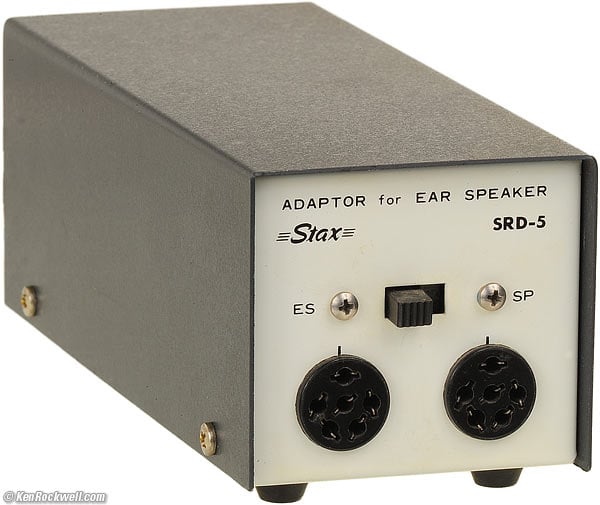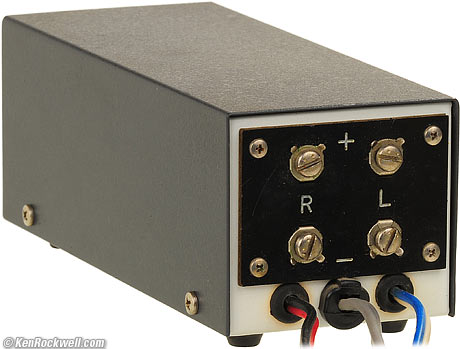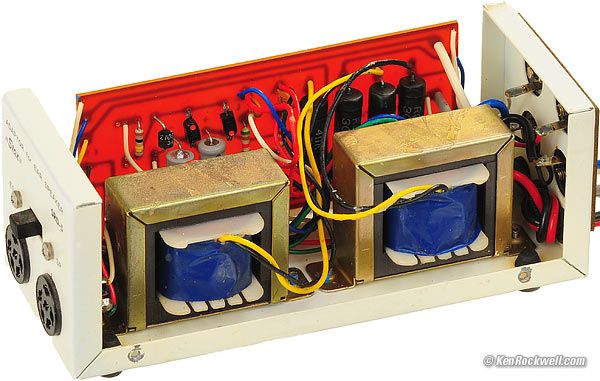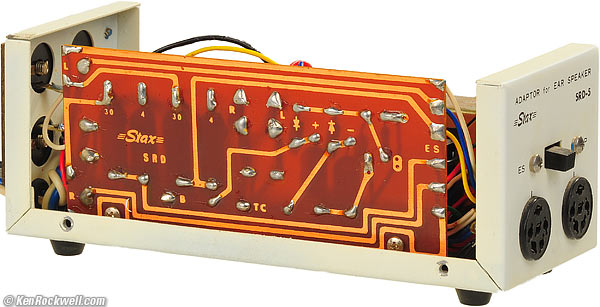Home Donate New Search Gallery Reviews How-To Books Links Workshops About Contact
Stax SRD-5 Energizer
(1968-1971)
© 2011 KenRockwell.com. All rights reserved.
Intro Specs Performance Compared Usage Recommendations
Stax SRD-5 Energizer/Adapter. enlarge. This free website's biggest source of support is when you use these links, especially this link directly to them at eBay, where they sell for about $50 (see How to Win at eBay). It helps me keep reviewing these oldies when you get yours through these links, thanks! Ken.
April 2011 All Reviews Audio Reviews Stax Reviews
Electrostatic Headphones: How They Work, and Why They Sound Better.
Audio-Technica Beyer Sennheiser Sony Stax Ultrasone Velodyne Woo
Introduction top
Intro Specs Performance Compared Usage Recommendations
|
I personally buy from Adorama, Amazon, Ritz, B&H, Calumet and J&R. I can't vouch for ads below.
|
The Stax SRD-5 is an adapter and high-voltage power supply to allow any of Stax' electrostatic headphones from 1959 through today to work from the outputs of any audio power amplifier or receiver. This energizer will not work with any other brand of headphone — just look at the 6-pin output jacks!
Originally the SRD-5 energizer shipped with Stax' SR-3 headphones, which Stax' marketing people have always preferred to call "earspeakers." The SRD-5 replaced 1960's SRD-1 and SRD-2, and remained Stax' top passive adapter until replaced by the much prettier SRD-7, which came out along with the Stax New SR-3 headphones in 1971.
While the Stax SRD-5's outputs only have the traditional 230 V bias voltage, Stax's newest professional-bias (580 V) headphones ("earspeakers") made since the 1980s work just fine, although with less sensitivity.
Rear, Stax SRD-5 Energizer/Adapter. enlarge.
Specifications top
Intro Specs Performance Compared Usage Recommendations
Input
Input impedance (ES, EarSpeaker position): not more than 30 Ohms anywhere in the audio band. 5 Ohms DC.
Cable Lengths: 6 foot power cord, three foot speaker cables.
Connect to power-amplifier speaker outputs.
Stax suggests that the power amplifier be rated at least 5 Watts.
While it doesn't go very loud, it works even when connected directly to the headphone jack of my iPod Touch!
Outputs
Headphones
Two special 6-pin high-voltage connectors, only for Stax headphones.
Both headphone outputs are connected in parallel with each other.
Speakers
When the front switch is in the LS (LoudSpeaker) position, the inputs are connected directly to the screws on the back, bypassing the step-up transformers for the headphones.
Materials top
Stamped-steel case.
Size top
Height includes rubber feet. These are actual measured values.
Millimeters: 66mm high x 67.6mm wide (70.9mm including screw heads) x 165mm deep (170mm including protrusions).
Inches: 2.60" high x 2.66" wide (2.79" with protrusions) x 6.5" deep (6.69" with protrusions).
Weight top
36.955 oz. (1,047.7g), with captive power cord and speaker cables.
Price top
When new, the SRD-5 was usually sold as part of a kit with headphones.
Today, the SRD-5 sells for about $50 used, by itself.
Interior and Transformers, Stax SRD-5 Energizer/Adapter. enlarge.
WARNING: Deadly voltage present even after being unplugged. Don't do this.
Electronic Schematic Diagram
Principal of Operation
Audio
The audio is stepped-up in voltage with two transformers, one for each channel. There is no active amplification.
The primary (input) of each transformer is completely separate from the other channel, therefore, reversing polarity for either channel is as simple as reversing the wires. Nothing is grounded.
Bias Voltage
The 230V bias voltage is created with an ordinary diode/capacitor voltage doubler connected directly to the power line through a 51k Ohm resistor.
This is fed to the center-tap of the output side of each transformer through a 1 megohm resistor, while the diaphragm of each transducer is connected to this voltage through a 27 megohm resistor.
Because the bias voltage comes from a source resistance of 28 megohms, attempting to measure it with a conventional digital voltmeter will read about half its actual value.
Switching
The ES (EarSpeaker) and LS (LoudSpeaker) switch connects the input either to the step-up transformers, or to the screw-terminal rear outputs for your regular speakers.
Performance top
Intro Specs Performance Compared Usage Recommendations
Sound Quality
See also Electrostatic Headphones: How They Work, and Why They Sound Better.
The SRD-5 doesn't have much of a sound of its own.
The biggest thing out for which to watch is the quality of source material and the quality of your power amplifier.
The biggest problem today could be with cheaper amps that have high self-noise levels, if it becomes audible through the headphones. I had no problems.
A big problem in its day, but not any longer, was that brand-new 1968 solid-state (transistor) amplifiers often had nasty zero-crossing ("crossover") distortion that sounded awful at the low levels at which one would often listen with these headphones. Today, that's all been fixed, as power amplifiers operate at least class AB, and no longer class B as did some very early transistor amps.
The biggest issue I noticed was only when abusing myself listening to 20 cps sine waves. I thought the New SR-3 headphones from 1971 with which I got this adapter had good, but limited output at 20 cps, but in fact, it turns out that these transformers were saturating. I wouldn't worry about it, they sound great, but if you want to deafen yourself with subsonic sine waves, instead use an actual Stax SRM or SRA amplifier (not a passive SRD adapter) for much more output at the lowest bass frequencies. With a Stax SRM-1/MK-2 Professional, the 1971 New SR-3 headphones had more clean 20 cps output than my 600 Ohm Beyer DT-990s!
The treble occasionally sounded a little congested with a New SR-3, but hey, for $50, the other 99% of things this little box does right are fantastic.
Power and Power Consumption top
The SRD-5 draws almost no power, maybe a tenth of a watt, just to create a static charge (bias voltage). The audio power comes from your external amplifier, not from this adapter.
There is no power switch.
When unplugged, because this all works on static charge, not moving electricity, it continues to operate for some time.
Mechanical Quality top
I'm impressed: the eight screws all seem to be made of stainless steel.
The case is stamped steel.
The feet are push-in rubber.
Safety top
There is no fuse. The power line is connected directly to the circuitry, although since the power line connects to the rest of the circuit via a 51k Ohm series resistor, there should be no fire hazard.
Circuit Board, Stax SRD-5 Energizer/Adapter. enlarge.
WARNING: Deadly voltage present even after being unplugged. Don't do this.
I don't know if mine was missing it, or if it never was part of the design, but there was no insulation between the bottom of this circuit board as seen here and the metal top cover!
If this board wiggled a bit, and if the sharp soldered connections scraped through the cover's gray paint, you could have the hot side of the power line connected directly to the outside of the case!
I put a sheet of fish paper in mine when I closed it.
There are no bleed resistors. When unplugged, the high 230 V bias voltage can stick around for a long time. If you're not a high-voltage certified technician, DO NOT OPEN THIS DEVICE, EVER, because deadly voltages can be in it even a long time after it's been unplugged. Ironically, this device has no "WARNING: HAZARDOUS VOLTAGE INSIDE" warnings on it. Stax presumes you know what this is.
Compared top
Intro Specs Performance Compared Usage Recommendations
I don't know that they sound any different, although I suspect newer SRD adapters may have larger transformers more suited to listening to 16 cps test tones.
Some of the newest SRD adapters support the 580 V Pro bias, but with Pro phones, I'd suggest a real amplifier over an adapter.
SRA and SRM active amplifiers are completely different, and I'd suggest them if you're serious with any of the more recent Stax headphones.
Usage top
Intro Specs Performance Compared Usage Recommendations
Connections
In no particular order:
1.) Connect the colored audio cables to your power amplifier or receiver. I forget which color was which, but it doesn't matter: since nothing is grounded, simply flip either channel's wires to change its polarity. If you want to flip the absolute polarity of the system, also no problem: flip both channel's connections.
2.) Connect the speakers which used to be connected to your power amplifier or receiver to the screws on the back of this SRD-5 energizer, or to another set of your amplifier's outputs.
3.) Plug in your headphones.
4.) Plug the energizer into the wall.
5.) Enjoy.
For use with an iPod, connect a 3.5mm plug to the input wires, and see if you like it. Most people will want more level and therefore want a dedicated Stax amplifier, but for a quick fix, this sounds great powered directly from my iPod's headphone output.
Charge Time top
This system uses static electricity, meaning non-moving (static) electric charges.
The static charge, a.k.a. polarizing voltage, is supposed to take a few minutes to spread around the headphone's diaphragm. If the charge was free to move at will, it would move under the forces that are supposed to move the diaphragm when subjected to voltage fields from the plates. If the charge was free to move (not static), electrostatic headphones and speakers wouldn't work.
Therefore, it takes time for the static charge to spread across the entire diaphragm.
As the charge spreads, it is normal for the audio to increase in level for the first few minutes after you've plugged the adapter into the wall. It's also normal for each channel to come up at slightly different rates, meaning it is expected that for the first few moments the channels often seem unbalanced.
Personally, I leave this thing plugged in and energized all the time, so my headphones are always ready to go. It's hard to measure, but electrostatic systems love to be left alone — that's why they're called static, and not dynamic. Some people say, and I wouldn't disagree with them, that electrostatic systems sound best if they're left plugged in for at least a day.
Safety top
The hundreds of volts of audio and polarizing voltages running around your head. These are the least of your worries.
As I covered under Safety, I'd have a certified high-voltage technician add some internal insulation. If you try to open the box yourself, you could be killed.
There is no fuse, but so long as the line voltage doesn't accidentally contact the case, there is a 51k Ohm resistor connected to one side of the line, which will prevent deadly current from that side of the line, but not the other. Since the plug isn't polarized, you're taking a 50% chance.
The 51k Ohm resistor in series with the power line should prevent any fire hazard in lieu of a fuse.
They biggest danger is to be careful when plugging and unplugging headphones from this Stax SRD-5 energizer. It is easy to touch the headphone-plug conductors accidentally with your fingers when the plug is partially inserted, which could give you one heck of a jolt.
Recommendations top
Intro Specs Performance Compared Usage Recommendations
This energizer, along with some of Stax earliest headphones like 1971's New SR-3, is one of the least expensive ways to get the best headphone sound available. If you really want great sound, you'll probably want a dedicated Stax amplifier, but if you're just wanting to hear how much more transparent electrostatic headphones are compared to ordinary headphones, this works.
For a total of only $150, delivered, over eBay, I got this adapter and a great pair of Stax New SR-3 headphones, and I greatly prefer this setup to the $1,500 pair of Sennheiser HD 800 headphones I bought — and promptly returned — a few months ago.
Electrostatic headphones are in a completely different class above the primitive electrodynamic (coil in a magnet) systems used in almost all mass-market headphones and loudspeakers, like the easy-to-buy Sennheisers and Ultrasones.
If you want to spend more, and you probably do if you're reading this, a $500 used dedicated amplifier like the Stax SRM-1/MK-2 Professional is much easier to use, since you can skip needing a power amplifier, and also has much more output, especially at very low frequencies.
A beauty of the Stax system is that every amplifier, energizer and headphone made since 1959 is pretty much compatible with everything else, with the only caveat being that the oldest (pre-1980s) headphones won't work with newer (post-1980s) amplifiers that only have Professional 5-pin (580V) outputs. The newest professional 5-pin (580 V) headphones work swell with these older adapters, if they this adapter is all you have.
Since any passive SRD adapter can bias these headphones without running a hot amplifier at the same time, you might want to use an offline (but plugged-in) SRD to keep your Stax phones at bias level, available to plug into another amplifier when you're ready to listen, with no need to wait for compete diaphragm charging.
If you find the time I spend reporting this helpful, this free website's biggest source of support is when you use these links, especially this link directly to them at eBay, where they sell for about $50 (see How to Win at eBay). It helps me keep reviewing these oldies when you get yours through these links, thanks! Ken.
Help me help you top
I support my growing family through this website, as crazy as it might seem.
The biggest help is when you use any of these links to Adorama, Amazon, eBay, Ritz, Calumet and J&R and when you get anything. It costs you nothing, and is this site's, and thus my family's, biggest source of support. eBay is always a gamble, but all the other places always have the best prices and service, which is why I've used them since before this website existed. I recommend them all personally.
If you find this page as helpful as a book you might have had to buy or a workshop you may have had to take, feel free to help me continue helping everyone.
If you've gotten your gear through one of my links or helped otherwise, you're family. It's great people like you who allow me to keep adding to this site full-time. Thanks!
If you haven't helped yet, please do, and consider helping me with a gift of $5.00.
As this page is copyrighted and formally registered, it is unlawful to make copies, especially in the form of printouts for personal use. If you wish to make a printout for personal use, you are granted one-time permission only if you PayPal me $5.00 per printout or part thereof. Thank you!
Thanks for reading!
Mr. & Mrs. Ken Rockwell, Ryan and Katie.
Home Donate New Search Gallery Reviews How-To Books Links Workshops About Contact







